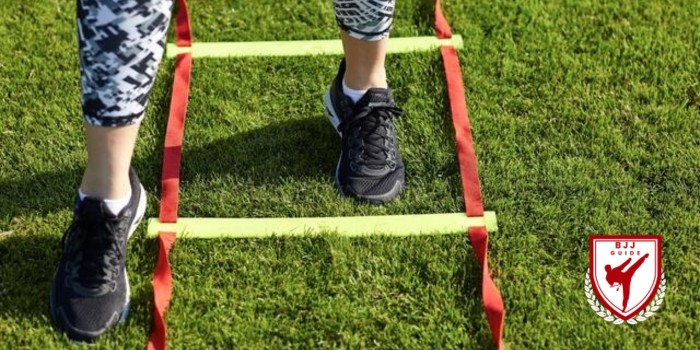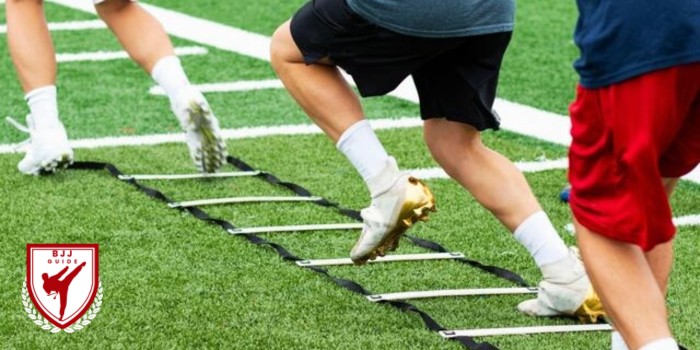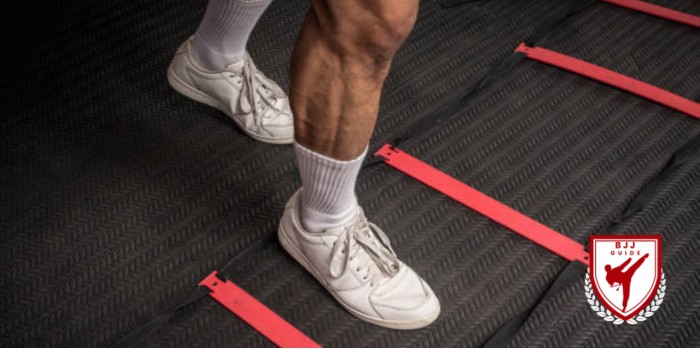Agility ladders have emerged as indispensable tools in the realm of fitness training, revered for their ability to enhance agility, speed, coordination, and overall athletic performance. In this comprehensive guide, we delve into the intricacies of this training, exploring its myriad benefits and providing valuable insights into its usage across various fitness settings.
Understanding Ladder Drills
It’s, also known as speed ladders or coordination ladders, are versatile training aids characterized by a series of adjustable rungs. These ladders are employed extensively in sports training, boot camps, and personal workouts to hone agility, footwork, and cardiovascular endurance. Available in different types and sizes, ladders cater to diverse training needs and preferences, ranging from compact portable versions to larger, more elaborate designs.

Benefits of Ladder Drills Training
The benefits of agility ladder training are manifold, encompassing improvements in agility, quickness, coordination, balance, and speed. By engaging multiple muscle groups and challenging the neuromuscular system, ladder drills offer a dynamic and exhilarating workout experience, fostering not only physical prowess but also mental acuity.
How to Use ladder for agility
Proper setup of the ladder for agility is crucial to ensure optimal training outcomes. Basic footwork drills such as high knees, lateral shuffles, and quick feet serve as foundational exercises, laying the groundwork for more advanced maneuvers like crossover steps and the icky shuffle. To maximize effectiveness and safety, attention must be paid to maintaining correct form and technique throughout the training session.
High Knees:
High knees are a dynamic exercise that involves rapidly lifting each knee towards the chest while maintaining an upright posture and engaging the core muscles. To perform high knees, stand with your feet hip-width apart, then alternately lift your knees as high as possible, aiming to bring them level with your waist or higher. Move your arms in sync with your knees for added momentum and balance. Repeat the movement at a brisk pace for a specified duration or number of repetitions to elevate your heart rate and improve cardiovascular fitness.
Lateral Shuffles:
Lateral shuffles are a lateral movement exercise designed to enhance agility, coordination, and lower-body strength. Begin by assuming a athletic stance with your knees slightly bent and feet shoulder-width apart. Keeping your hips low and chest up, take short lateral steps to the side, crossing one foot over the other without allowing your feet to come together. Maintain a consistent rhythm and focus on pushing off forcefully with each step. Lateral shuffles can be performed over a designated distance or within a confined space, making them ideal for sports-specific training and overall conditioning.
Quick Feet:
Quick feet drills are dynamic exercises that target speed, agility, and footwork proficiency. Start in a standing position with your feet hip-width apart and knees slightly bent. Begin by rapidly tapping your feet on the ground in place, maintaining a quick and light cadence. As you become more proficient, incorporate variations such as moving forward, backward, or sideways while maintaining the rapid foot taps. Quick feet drills can be performed for short bursts of high intensity, serving as an effective warm-up, conditioning exercise, or agility training component in your workout routine.

Integrating Ladder Drills Exercises into Your Workout Routine
Incorporating ladder drills into your warm-up, main workout, and cool-down phases can augment the efficacy of your fitness regimen. Whether you’re designing a high-intensity interval circuit or seeking to improve flexibility and range of motion, ladder exercises offer unparalleled versatility and adaptability to suit your training objectives.
Simple Agility Drill Exercises:
Simple agility drill exercises are fundamental movements aimed at improving agility, speed, and coordination. These drills typically involve quick changes of direction and rapid movement patterns to challenge the body’s neuromuscular system. Incorporating simple agility drills into your workout routine can enhance athletic performance and overall fitness levels.
Single Foot Agility Drill:
The single foot agility drill is a dynamic exercise that focuses on agility, balance, and proprioception. Begin by standing on one foot with the other foot lifted slightly off the ground. Then, using the planted foot as a pivot point, perform quick side-to-side movements, hopping or jumping laterally over a designated marker or imaginary line. Maintain stability and control throughout the movement, engaging the core muscles to stabilize the body. Repeat the drill for a specified duration or number of repetitions before switching to the other foot.
Two-Foot Agility Drill:
The two-foot agility drill is a dynamic exercise designed to improve agility, quickness, and footwork coordination. Start by standing with your feet hip-width apart and knees slightly bent in an athletic stance. Then, using both feet simultaneously, perform rapid side-to-side movements, shifting your weight from one foot to the other while maintaining balance and control. Focus on staying light on your feet and moving with quick, explosive bursts of energy. This drill can be performed over a designated distance or within a confined area, making it suitable for sports-specific training or general conditioning purposes.

Ladder Training for Different Sports
Tailoring agility ladder drills to the specific demands of various sports enables athletes to sharpen their skills and gain a competitive edge. From soccer and basketball to football and tennis, sport-specific ladder agility exercises target key movement patterns and enhance performance attributes essential for success on the field or court.
Common Mistakes to Avoid
Avoiding pitfalls such as neglecting proper form, prematurely progressing to advanced drills, and overlooking the importance of warm-up and cool-down routines is essential for injury prevention and optimal training outcomes. By adhering to sound training principles and gradually advancing through skill levels, individuals can mitigate the risk of injury and maximize their athletic potential.
Tips for Buying an Agility Lader
When selecting an ladder for agility, factors such as material quality, length, width, and durability warrant careful consideration. Consulting user reviews and expert recommendations can aid in identifying reputable brands and products that align with your specific needs and preferences, ensuring a worthwhile investment in your fitness journey.
Conclusion
In conclusion, agility lader training stands as a cornerstone of modern fitness regimens, offering a multifaceted approach to enhancing athletic performance and overall well-being. By embracing the versatility and effectiveness of agility laders, individuals can unlock their full potential and embark on a journey toward mastery of agility, speed, and coordination. So, seize the opportunity to elevate your fitness routine and experience the transformative power of ladder training today!
FAQ's (Frequently Asked Questions)
Q: What is an agility ladder?
Ans: This is a fitness tool consisting of adjustable rungs arranged parallel to each other. It’s used for agility training, improving footwork, and enhancing overall athletic performance.
Q: Does the agility ladder really work?
Ans: Yes, when used correctly, the agility lader is effective for improving agility, speed, coordination, and cardiovascular fitness. It engages multiple muscle groups and challenges the neuromuscular system.
Q: How long is an agility ladder?
Ans: This is vary in length, typically ranging from 10 to 15 feet, depending on the manufacturer and design. Choose the length based on available space and training goals.
Q: What muscles does the agility ladder target?
Ans: Ladder drills target muscles throughout the body, including the lower body (quads, hamstrings, calves), core, and upper body (arms, shoulders, back), providing a comprehensive full-body workout.
Q: What are the benefits of an agility ladder?
Ans: Benefits of this training include improved agility, speed, coordination, cardiovascular endurance, and transferability to sports-specific skills. It offers a versatile and engaging workout suitable for all fitness levels.


